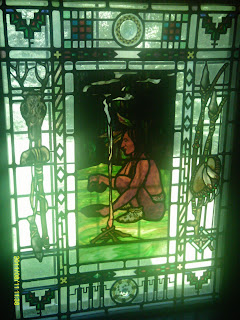Last Thursday, my mom and I went to this small museum called Indian Steps museum.
(the way Indian Steps got its name was, back a few hundred years, Indians that lived along the Susquehanna carved steps into the rocks along the river, that were footholds to make fishing easier. these steps have been underwater for quite some time though.)
Indian Steps museum was started by a man named John E. Vandersloot.
He found the area when he was on an outing with his friends. He instantly loved the property and bought it.
While he was gardening, he would find arrow heads, stone tools, pottery and other little pieces of artifacts. He also collected artifacts that his neighbors would share with him. After a while, he had quite a large collection. During the construction of Vandersloot's cabin (which is now the museum building) he had more then 10,000 of the artifacts embedded into the stones to form designs, like birds, animals, reptiles and to tell the story of the Indians that had lived there.
When Vandersloot died in 1936, his property was acquired by Pennsylvania Water & Power Company, owner-operator of the hydro power plants at Holtwood, three miles down the stream. In 1939, the company leased the estate to the Conservation Society of York County, founded in 1922. In 1955 Pennsylvania Power and Light Company bought the assets of the former company, and on December 3, 1956, PP & L presented the estate to the Society for the payment of 'one dollar.'
It's very unlikely that Vandersloot thought that anything would come from his hobby, let alone a whole museum. But I'm sure he would be glad that everything is being kept for people to see and learn about.
You can tell, by the inscription that is carved into a stone above the doorway to enter the museum that says :
"I entreat all those who pass this way to safely guard and preserve these former possessions of and monuments to an ancient Indian people.
John Edward Vandersloot,
Owner and Builder, Indian Steps Cabin, 1912"
Owner and Builder, Indian Steps Cabin, 1912"






0 comments:
Post a Comment